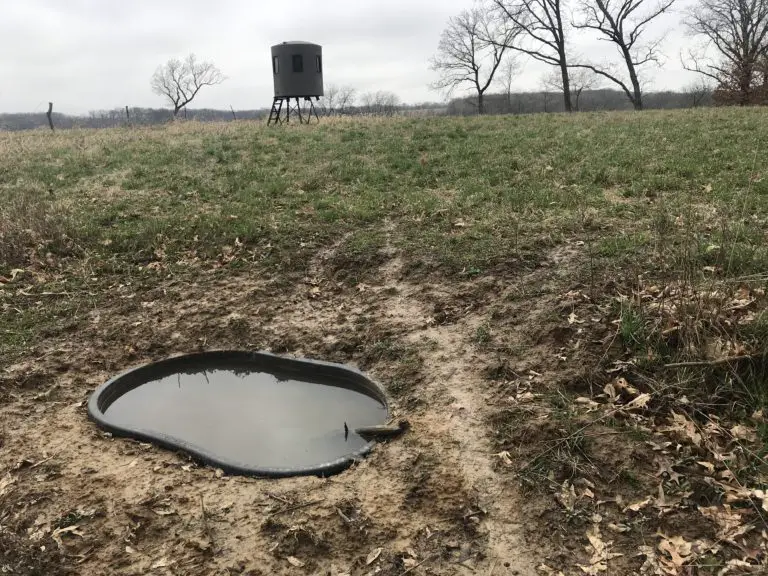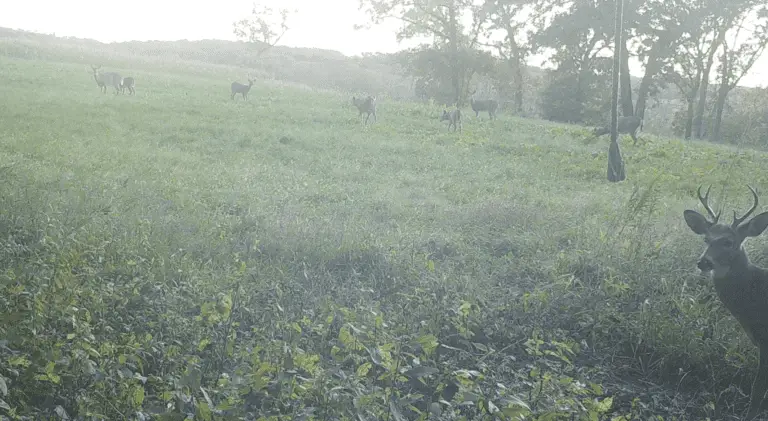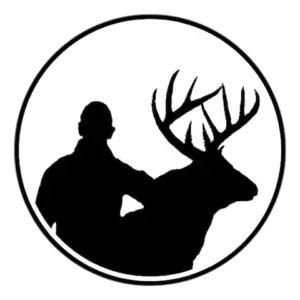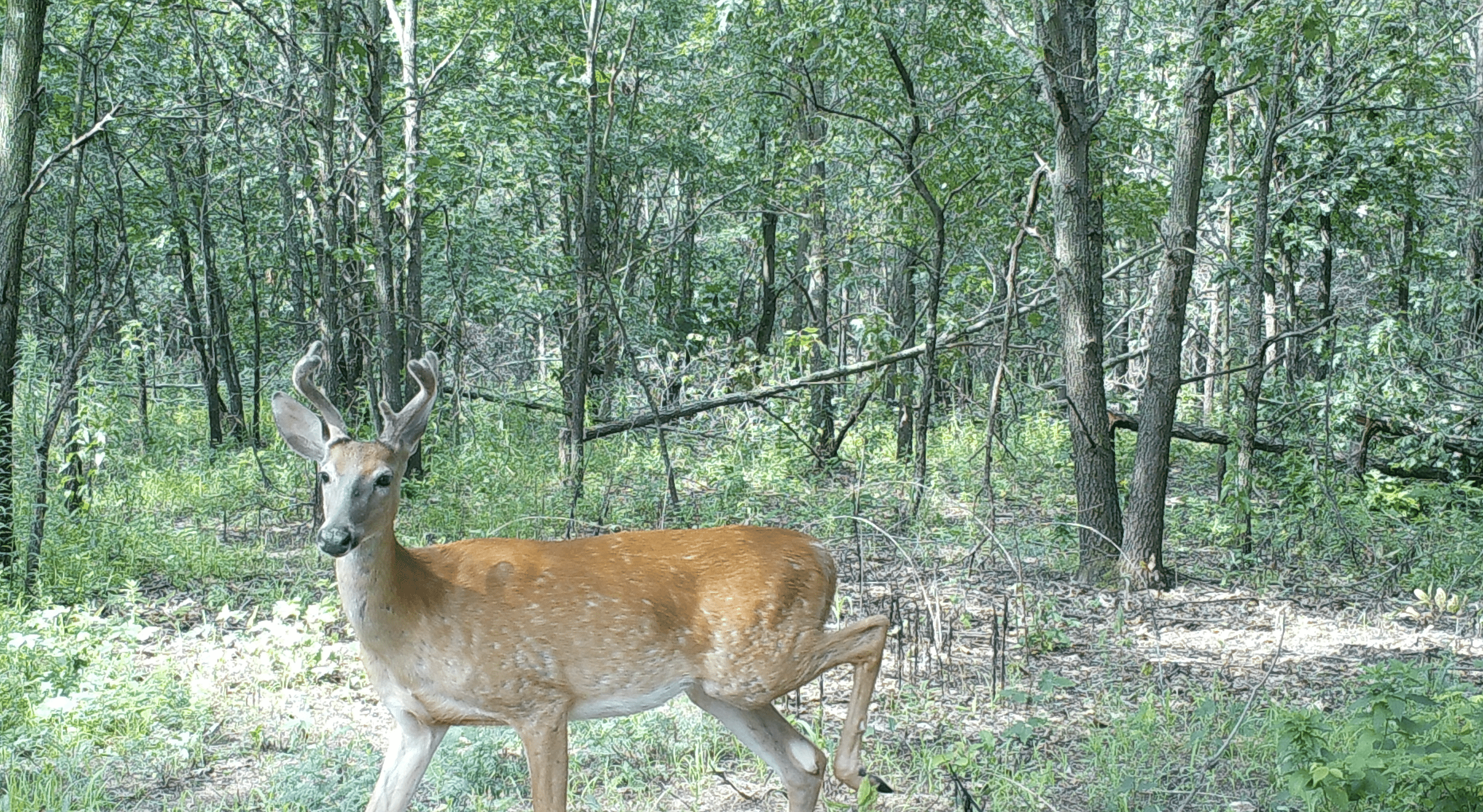Are you seeing several small bucks while hunting but can’t seem to lay an eye on a big buck? If so, you’re not alone. Many hunters face this frustrating situation every hunting season and will go many years in a row without seeing a big buck.
There are several potential reasons why you are only seeing small bucks. In most cases, there is more than just one reason to explain it. Deer need food, water, and cover to meet their basic needs for survival. However, in most cases there is a deeper explanation why you only see small bucks than just a lack of food, water, or cover. Read along to see why you are only seeing small bucks and not big bucks.
26 reasons why you only see small bucks and not big bucks:
1. There are only small bucks in your area
To see a big buck, he must exist first. Make’s sense, right?! Start running a trail camera in August to see if you can get a picture of a big buck. If you run a trial camera for several months and all you see is small bucks and no big bucks, then you can’t expect to ever see a big buck while hunting. I don’t want to say it can’t happen, but the odds of it happening are extremely unlikely.
2. You’re not good at judging a buck’s size
Judging a buck’s size isn’t always straight forward. Sometimes the body of a buck can be much bigger than normal which can make his rack look smaller than it is. The opposite effect can happen also. If you have ever shot a big buck that ended up being smaller than you thought, you know exactly what I mean. One time I found a match set of shed antlers that belonged to a buck that I passed that season. When I got my hands on those shed antlers, I realized the buck was much bigger than I thought he was and I should have probably shot him.
3. Other hunters have killed the big bucks
If there aren’t many big bucks in your neighborhood then it’s possible someone already shot them. How many big bucks are there in your neighborhood compared to the number of hunters in the neighborhood? If you have one big buck for every ten hunters, then the odds are stacked against you unless you do something different from your neighbors to encourage that buck to walk in front of your stand instead of theirs. If all the big bucks are already shot then you will only ever see small bucks while hunting.
4. Surrounding hunting pressure has spooked them
How much hunting pressure is there on the property you hunt or the properties that surround it? If hunting pressure is severe then big bucks will move to safer areas or limit their movement until it gets dark outside. Small bucks are typically younger bucks and don’t always respond to hunting pressure like a mature buck would. You could still see small bucks with a lot of hunting pressure, but mature bucks will be much more difficult to see during the daytime. Learn how to use an aerial map to find mature bucks.
5. You’re not playing the wind
If you allow your wind to blow toward areas where deer are likely to be then your odds of seeing deer aren’t going to be very good. The more you hunt an area and educate deer of your human intrusion the less deer you will see over time. Young bucks that are one or two years old are more tolerant to human pressure than deer that are three or older. If you know big deer exist in your neighborhood but you are only seeing small bucks, then you need to ask yourself a question: Do deer know when they are being hunted?
6. You have bad entry/exit routes
Even if you are playing the wind correctly, that doesn’t necessarily mean that deer couldn’t hear you or see you entering or exiting your hunting location. If you have trouble accessing your property without deer hearing or seeing you, then try to get creative with how you access your hunting locations. If you own the property you hunt on, you might want to consider installing screens on your property. Click here to learn more about screens and how you can turn a property with bad access into good access.
7. No water
Deer get most of the water they need from the plants they eat. However, depending on the environment where you hunt and the weather, a water source can attract bucks and keep them close by so that you can see them. A water source can be just the thing you need to see a big buck instead of a bunch of smaller bucks.

8. Not enough food
Deer need to be well fed and get the minerals they need to grow a large rack and express their full antler growing potential. Deer obviously need food to survive, and they want to eat several times throughout the day. You might only be seeing small bucks because the big bucks are staying close to primary food sources. Also, big bucks might be territorial and push smaller bucks away from primary food sources which is why you could be seeing small bucks and not big bucks.
9. Too much food
If you have too much food, you might only be seeing small bucks because food is everywhere and not centrally located. If food is everywhere and big bucks don’t have to move very far to eat, then you might never see them. Ideally, you will have a variety of foods in just a few locations to increase buck movement from bedding areas to primary food sources. Having centrally located feeding areas in just a couple of spots will increase your odds of seeing big bucks and not just small bucks.
10. Not enough cover
If you don’t have enough cover for big bucks to hide in, you are probably only going to see mostly small bucks and does. Learn more about this and see what you can do to fix it by reading the following article: Why do I never see bucks. Cover needs to be thick enough so that deer can hide within it. If you can see more than 50 yards through cover then you need to thicken it up.
11. No sanctuary in the area
You might only be seeing small bucks because there isn’t a sanctuary close by. Big bucks are spending most of their daylight hours in places where they feel the safest. A sanctuary is a place where deer are not likely to see, hear, or smell a human. If you don’t have a place where deer can bed without human intrusion alerting them, you are going to have a difficult time seeing big bucks.
12. Not hunting close enough to big buck beds
Big bucks are not always bedding in a “sanctuary”. Sometimes an area can be hunted so hard that there are no safe places for a buck to hide. If a mature buck doesn’t feel safe, then he will wait until it gets dark before starting to make his way to feeding areas. In situations like this, you might only see small bucks because the mature bucks are much smarter and less tolerant of human intrusion. You must get close to the spot where a big buck beds if you are going to have a chance at seeing him.
13. Not going deep enough or far enough
If you feel like you are getting close enough to places where a big buck beds but you are still only seeing small bucks, you may need to go deeper. Doing deeper means getting further away from areas of human intrusion and other hunters. Going deeper doesn’t always mean you are going further into the bedding cover, although it could mean that. Ideally you don’t want to intrude into areas where other deer are likely to be, but if you are hunting vast amounts of public lands then you might need to. If you are doing this then try to never hunt the same location twice. Deer will learn about your intrusion quickly and might change their routine to avoid the areas where you have been.
14. Poor genetics
Its possible the genetics in your area aren’t very good and bucks are not able to grow a big set of antlers. If a buck has poor antler genetics in comparison to the rest of the bucks in that area, then he is going to keep growing a smaller rack than what is typically for that area.
15. Age Structure
If there are only young deer in the neighborhood then you are most likely only going to see bucks with small racks. In most situations, young deer that are two years old or younger will have small racks and deer that are four years old or older will express more of their antler growing potential. If you don’t have bucks in that three or four-year-old range, then you can expect to see mostly small bucks. Sometimes young bucks have incredible genetics and will grow a big rack at a young age (one or two-years-old), but this is not the norm.
16. Not enough does
When there aren’t many does to breed, there will be more competition among bucks to breed those does. The more fights that big bucks have the more likely they are to get injured or die. What happens if your area only has two big bucks and they get in a fight and get their antlers locked up together. If they can’t get unstuck then both of those bucks will die and there will be no more big deer in your area to hunt, leaving only the small bucks.
17. Too many deer
If a buck doesn’t have to travel very far to breed does because there are a lot of does around him, then it’s possible that buck won’t travel very far from his primary bedding and feeding area. On the other end of the spectrum if a buck is a loner he may try to be alone as much as possible and avoid the social pressure of other deer being around. The timing of the season and individual buck personalities will help determine if you will see big bucks on your property or not.

18. Your hunting strategy and property layout aren’t working together
If your hunting strategy and property layout are not encouraging deer to spend time on your property, then you will probably have a hard time seeing anything other than small bucks and does on your property. The best way to consistently see the biggest buck in your neighborhood is by having a hunting strategy and property layout tactically planned out and executed. Read this to learn how to set up a property for deer hunting.
19. Not hunting where big buck sign is
Big buck sign is unmistakable. If you don’t see big buck sign on the lands where you are hunting then you are probably not going to see big bucks. The size of a bucks’ track will help you understand if it’s a young deer or an older deer’s track. Old bucks will typically have bigger racks, but not always. Also, a rub that’s made on a tree at least ten inches or wider in diameter is usually made by large racked buck. The tree should be completely shredded and not just scratched up. Little bucks can scratch big tress so don’t be tricked by that. Also, another hint of big buck rubs is when they are made higher up the truck of a tree than normal. Big bucks will rub small tree’s just like small bucks will.
20. You’re hunting main trails
Small bucks and does will walk during daylight hours through areas that are frequently used and offer a path of least resistance. If you want to start seeing big bucks in your area, you should try to get away from main trails. Will a big buck use a main trail? Yes, they will. But most of the time this is not the case. Put yourself in the best position to increase your odds at seeing a big buck by getting away from the main trails.
21. You’re not putting enough time in the stand
Do you expect to see a big buck every hunt? What about every two or three hunts? Let’s face it, some areas have much better odds of your seeing bigger bucks more frequently. Sometimes you just need to grind it out and put in your time in the stand. Hunting is unpredictable most of the time. Some years you might see a big buck on the first hunt, and other years you might have to wait more than a week before you see a big buck in the same area. The more time you spend in the stand the better your odds will be at seeing more than just small bucks.
22. You’re not hunting during the middle of the day
How many big bucks are walking past your stand during the middle of the day? You might be surprised how important it is to hunt during the middle of the day even though odds would tell you to prioritize your hunts to happen during the mornings and evenings. At the time I’m writing this article, there is a property that I have permission to hunt where I have shot four big bucks over the course of several years. Two of those bucks where shot between 11am – 1pm. That particular property always seems to have good big buck movement during the day, so I took advantage of it. If you can hunt all day during the rut, then do it!
23. You’re hunting at the wrong times
Sometimes we just have bad luck as hunters. During my hunting career, there has been several times where I hunted a property without seeing a big buck and then I find out later with my trail camera that a big buck was walking through a different part of the property at the same time I was hunting. Also, every hunting location should have a hunting strategy to go with it. If you aren’t hunting stands at the right time or at the right time of year then you could be alerting those deer. Sometimes big bucks just don’t read script, even if you have done everything according to plan.
24. You’re stuck in a rut
Don’t keep doing the same thing and expect a different result. If you hunt the same stand over-and-over and all you see is small bucks, do you really think you should keep sitting in that same stand? No, you shouldn’t. You need to change things up if you want to change your luck. Get creative, try new hunting strategies, and experiment with all the different aspects of your hunting strategy.
25. Disease killed the big bucks
If you ever heard of Blue Tongues or Hemorrhagic Disease, then you know that deer die from diseases. In some cases, disease can kill a large majority of the deer herd in an area. If you are only seeing small bucks, then it’s possible the bigger bucks in your neighborhood died from disease.
26. Bad management by state agencies (DNR)
State agencies can make a huge impact on the quality of the deer herd with rules and regulations. How many buck permits does a state issue, how many bucks can a hunter take per season, how long does the hunting season last for, does the state allow baiting, and how long are the gun seasons? These are just a few questions to help determine what the quality of the overall deer herd is for large areas. If a state is not managing a deer herd well, it’s more likely to have a herd with larger number of younger bucks than older bucks.

